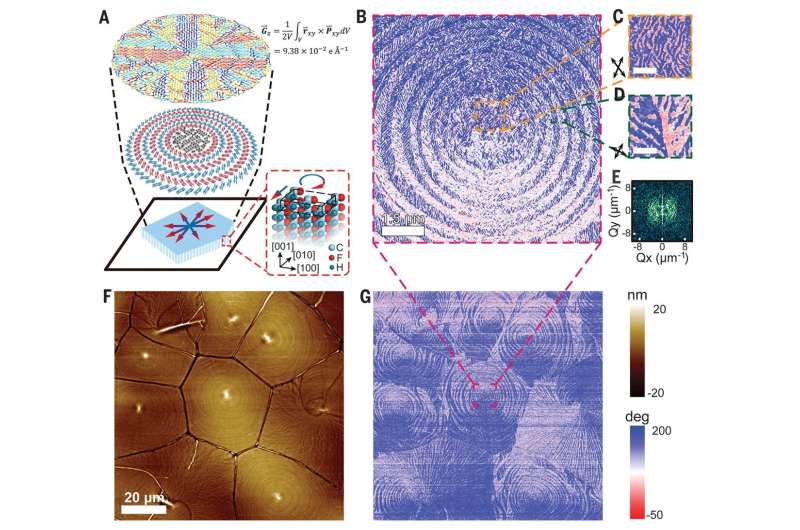Observation of toroidal polar topology. Credit: Science (2021). DOI: 10.1126/science.abc4727
A team of researchers from China, the U.S. and Australia has found an example of the formation of concentric circular bands of polarization in a ferroelectric polymer. In their paper published in the journal Science, the group describes the creation of whirlpools at the nano- and microscale and possible uses for the resulting toroidal textures in their materials. Lane Martin with the University of California, Berkeley, has published a Perspectives piece in the same journal issue outlining research involved in creating tiny whirlpools and the work by the team on this new effort.
As Martin notes, prior research has shown that whirling structures have been seen in magnetic materials but it was believed that similar structures would not be possible with ferroelectric materials—this is because their polarization is so strongly tied to a lattice.
Recently, other research teams reported that by controlling their elastic, gradient and electric energies, ferroelectric materials could occupy a state in which no single energy dominated the material. They found that nanoscale features could be achieved that were once thought impossible in such materials. In this new effort, the researchers have extended this research to create materials with concentric circular bands of polarization in a ferroelectric polymer. The researchers note that they look like tiny targets.
To create the toroidal textures, the researchers worked with the polymer P(VDF-TrFE). They used a melt-recrystallization process that resulted in the formation of ring-shaped bands with what the researchers describe as a wrinkled topography. Study of the process showed a large strain that resulted in competition between the three energy types, resulting in a concentric rotating structure. The structure was also found to be toroidal. The researchers noted that while some superlattices have been observeed with topologies at the 10-nm scale, those they were creating were at the 100 to 1000nm scale.
The researchers also found that the material responded in surprising ways when probed. They found, for example, that there was continuous rotation of the toroidal structures that were perpendicular to the polymer chains—but parallel to them, there was a relaxor-like response.
More information: Mengfan Guo et al. Toroidal polar topology in strained ferroelectric polymer, Science (2021). DOI: 10.1126/science.abc4727
Lane W. Martin. Whirls and swirls of polarization, Science (2021). DOI: 10.1126/science.abg4477
Journal information: Science
© 2021 Science X Network
























